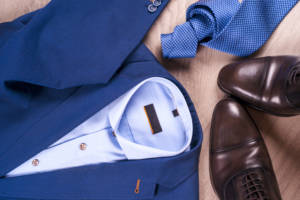Smart Tips for Your Wedding-Day Suit

If you plan to wear the always fashionable suit at your wedding, read on to learn more about the various options to gain a better understanding.
Suits are a classic wedding attire choice. With the right cut and tailoring, they can be expertly fashioned to flatter a wide range of body types. If you plan to get married in a suit but aren’t familiar with their design details, take heart. Understanding the anatomy of this timeless ensemble can assist you in making the best apparel choice for your big day.
Suiting 101: A Basic Breakdown
Esquire writer Hans Aschim diagrams a suit’s components in a May 2018 piece. As a key detail, jacket lapels define the suit’s overall look. Most fall into one of three categories:
- Notch, the classic tightly angled lapel
- Peak, cut out and point up to the shoulders
- Shawl, a smooth lapel with no notches
Vents are constructed in the back of a jacket and permit the wearer freedom of movement. A single vent in the center is the most common. Meanwhile, double-vent styles place one on each side seam and can be more comfortable for some individuals.
A suit’s drop refers to the difference between the jacket’s chest measurement and the trousers’ waist size. The average drop is usually 6 inches, but that number can be higher for folks with wider shoulders and narrower waists. Conversely, it can be lower in portly individuals with larger waistlines.
Finally, the “break” refers to the amount of trouser fabric hem gathering at the shoe. He Spoke Style describes the various trouser breaks typically available and the looks they create. No break or a slight break style are modern and fashion-forward, while medium and full breaks tend to be more conservative.
Looking Great Begins With Correct Suit Fit
Tailors can expertly alter a garment to your dimensions, but there are key areas in which proper fit is essential in the first place. As Art of Manliness points out, jacket shoulders are notoriously difficult to alter. It’s also hard to modify a trouser seat that’s too loose, fix sleeves attached at an incorrect angle, or make extreme adjustments to a jacket’s closure or bottom hem.
GQ’s editors discuss an ideal fit in an October 2015 article. Many wearers overestimate their jacket sizes, so you should select yours as true to your body size as possible. Your jacket’s shoulder seams should end right at your shoulder blades. Make sure that the jacket’s lapels lie flat on your chest when it’s buttoned. Ideally, the jacket should also fit snuggly around your torso. Your trousers must sit at your natural waist, with legs that aren’t baggy or excessively wide and hems ending around the tops of your shoes.
Pay Attention to Vital Details
Structure and fit are important when you’re shopping for suits. To guide you in fine-tuning your look, Martha Stewart Weddings provides some useful tips. First, you should choose items that align with your typical style. Super-trendy selections aren’t usually a good idea unless they’re already part of your everyday fashion. Next, keep in mind that neutral shades such as gray, tan, navy, or black easily complement or match other colors. Choose your fabrics according to the season, saving wool and cashmere for cooler weather and lighter options such as linen and seersucker for summer. If you find the world of alterations a little confusing, the editors recommend carrying a “cheat sheet” to help you communicate with your tailor. Jackets should nip at the waist but avoid pulling on its buttons. Ask for shirt sleeve hems that extend ¼ inch below your jacket sleeve when your arms are at your sides. Ideally, trouser hems should graze your shoelaces.
Suits are a perennial sartorial staple, with a wide range of customization options for nearly any wearer. With carefully chosen details such as cut, fit, fabric, and color, this expertly tailored garment is an important foundation of your wedding-day look.

